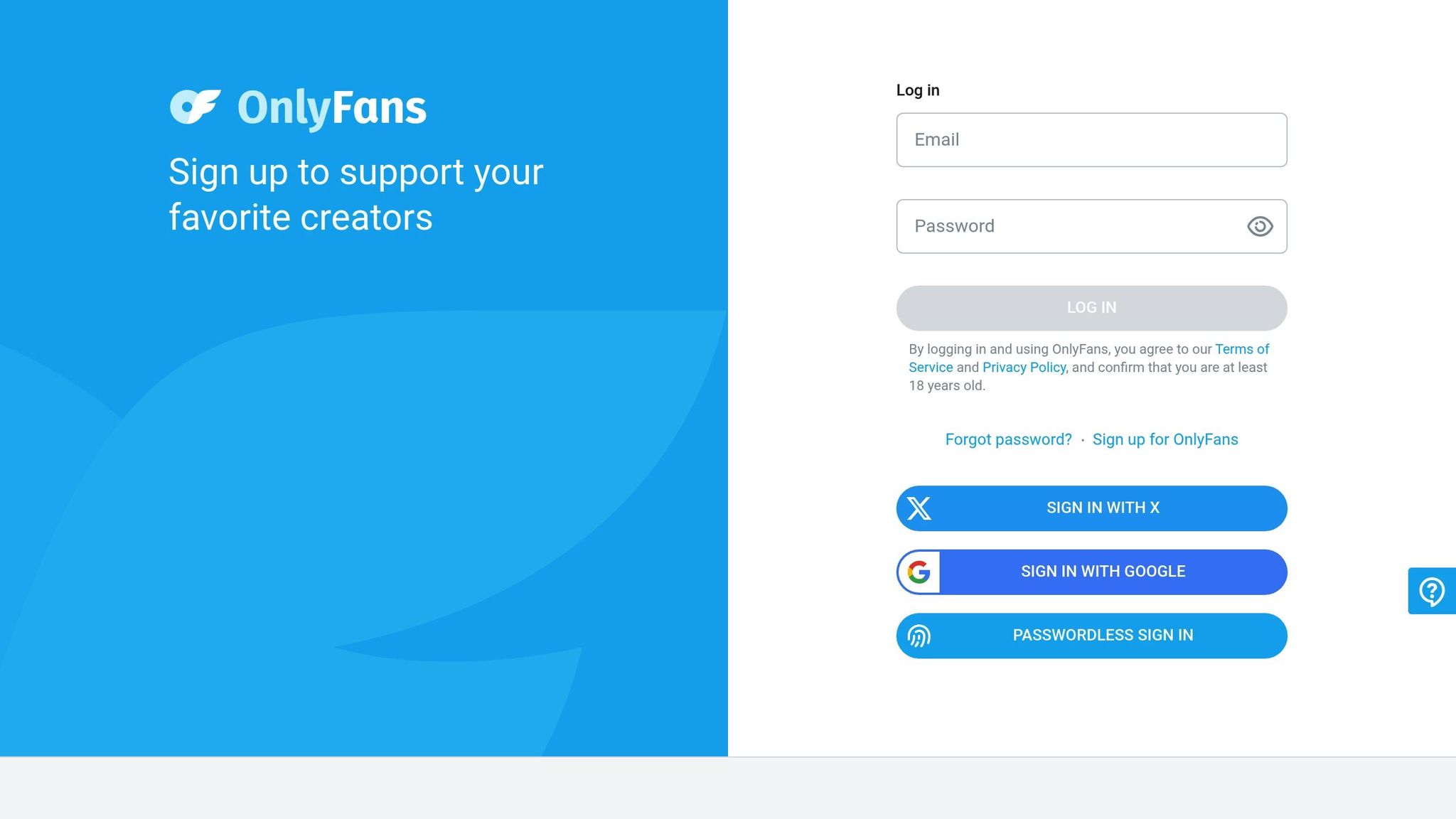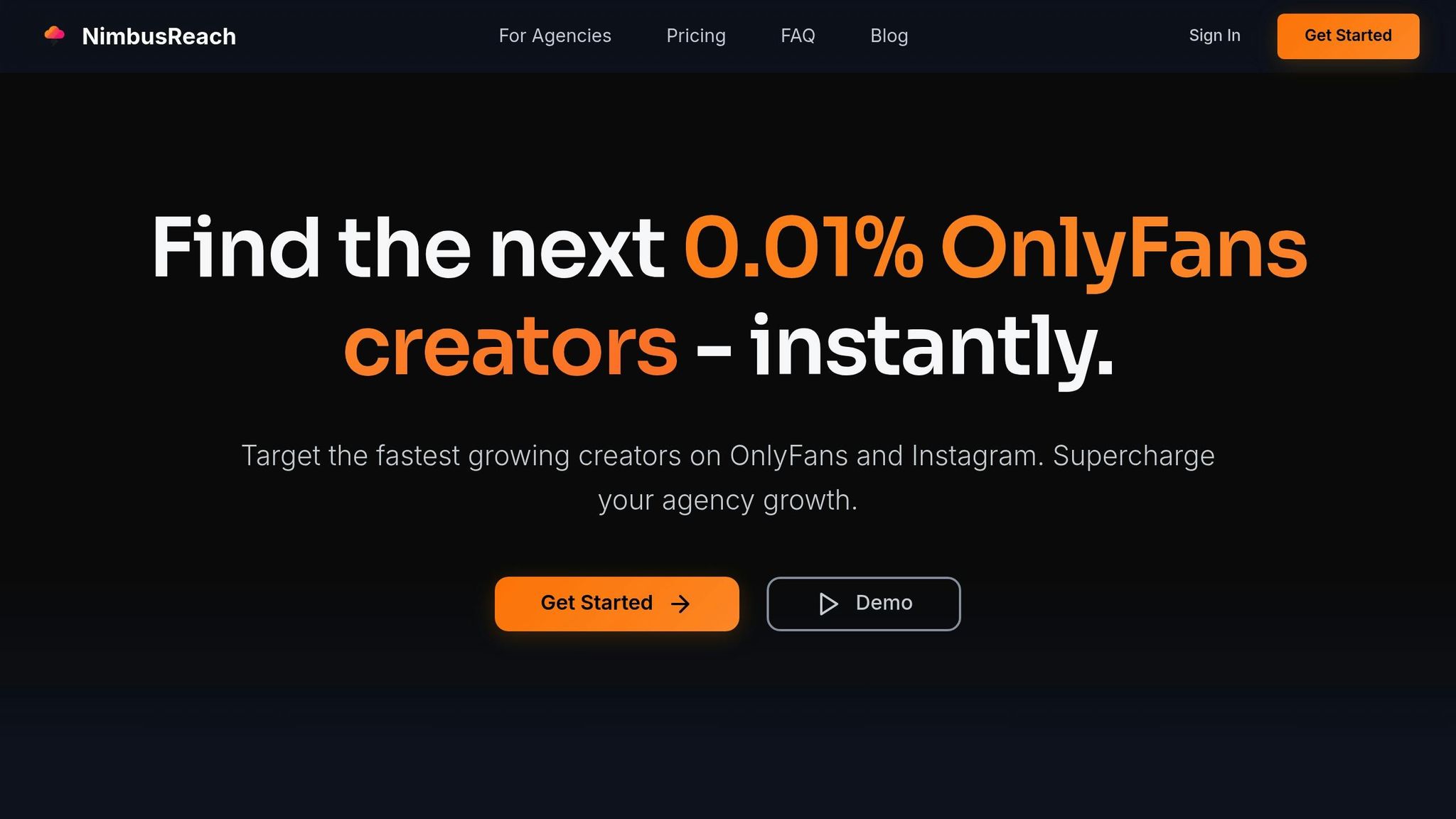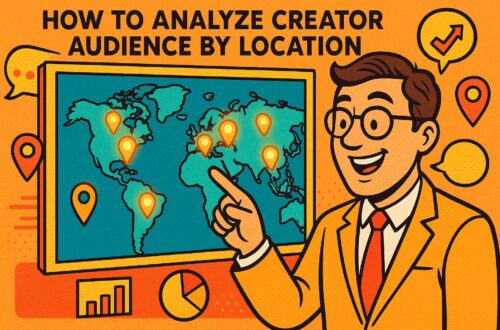Managing an OnlyFans agency involves balancing creator satisfaction, legal compliance, and operational efficiency. Here’s what you need to know:
- Commission Models: Choose between percentage-only, fixed fee + commission, or sliding scale models. Each has pros and cons, depending on your agency’s goals and creator needs.
- Legal Compliance: Contracts, tax filings (W-9, 1099-NEC), and content rights are critical. Missteps can lead to legal and financial issues.
- Payments: Automate payments with tools like Stripe or Paxum. Offer clear schedules (weekly, bi-weekly, or monthly) and multiple payout options.
- Software Tools: Use platforms like NimbusReach for creator discovery, CRM systems like HubSpot for management, and analytics tools to track performance and earnings.
Success comes down to offering fair terms, maintaining transparency, and leveraging the right tools to streamline operations and scale effectively. Let’s dive deeper into these strategies.
5 Crucial Tools for OnlyFans Agencies

Common Commission Models for OnlyFans Agencies
OnlyFans agencies typically choose from three main commission structures, each with its own pros and cons. These models aim to balance simplicity, predictability, and growth incentives, depending on the agency’s goals and the needs of their creators. Let’s break down these models to help you decide which one might work best for your agency.
Percentage-Only Commission Model
This is the simplest option: the agency takes a fixed percentage of the creator’s earnings. It’s easy to understand and implement, making it appealing for agencies that value transparency. Creators can clearly see how much they’ll take home, and agencies can estimate their revenue based on how well their creators perform. Essentially, the agency’s income rises and falls with the creator’s success.
That said, this model can be tricky during slow months. If a creator’s earnings dip, the agency’s revenue takes a hit too. To strike a balance, some agencies opt for a moderate commission rate when offering full management services. Agencies providing lighter support might go for a lower percentage to stay competitive.
Fixed Fee Plus Commission Model
This hybrid model combines a fixed monthly fee with a lower commission percentage. For example, an agency might charge a set monthly fee to cover baseline costs and then take a smaller cut of the creator’s earnings.
The fixed fee offers reliable income for the agency, covering operational expenses regardless of the creator’s performance. Meanwhile, the commission component allows the agency to benefit from the creator’s growth. Creators with steady or high earnings often find this model appealing since the fixed fee becomes a smaller share of their overall income. However, creators with fluctuating earnings might struggle during slower months when the fixed fee feels like a bigger burden.
Sliding Scale Commission Model
In this model, commission rates vary based on the creator’s earnings. Typically, creators start with a higher rate, which decreases as their income grows. This structure rewards successful creators with lower rates while ensuring newer creators – who often need more support – contribute more initially.
While this approach can attract creators focused on growth, it comes with added complexity. Agencies need systems to manage the variable rates, and creators must fully understand how their payments are calculated. There’s also the risk of an "earnings cliff", where creators might adjust their strategies to stay in a lower commission bracket, potentially impacting agency revenue.
| Commission Model | Best For | Monthly Revenue Stability | Administrative Complexity |
|---|---|---|---|
| Percentage-Only | New agencies, simple setup | Fluctuates with creator performance | Low |
| Fixed Fee + Commission | Agencies with steady clients | More stable with a mix of fixed and variable income | Medium |
| Sliding Scale | Growth-oriented creators | Varies, with potential for higher earnings | High |
Legal Requirements for OnlyFans Management Agencies
Running an OnlyFans management agency in the U.S. comes with a host of legal responsibilities. Staying compliant is essential to safeguard your business and the creators you work with.
Clear Contracts and Fair Terms
Every creator agreement should lay out the specifics – terms, deliverables, and payment details. This includes the commission structure, whether it’s a percentage-based model, a flat fee plus commission, or a sliding scale. The contract should also specify the services your agency provides, such as social media management, content scheduling, customer interactions, or marketing support. Clearly define timelines and deliverables for these services to avoid misunderstandings. Payment terms must outline when creators will receive their earnings, how payments will be processed, and any applicable fees.
Termination clauses are just as critical. Both parties need a clear process for ending the agreement if things don’t work out. Many agencies include a notice period – typically around 30 days – while others might prefer different timeframes. The contract should also address how content, social media accounts, and ongoing campaigns will be handled after the relationship ends.
Beyond contracts, compliance with tax and labor laws is non-negotiable.
U.S. Tax and Labor Law Compliance
Creators working with your agency are typically classified as independent contractors, not employees. This distinction comes with specific tax obligations. For instance, you’ll need to collect a Form W-9 from each creator before issuing payments. If a creator earns more than $600 in a tax year, you must file a Form 1099-NEC by January 31 of the following year. Many agencies use payroll or accounting software to streamline these filings and avoid costly mistakes. Missing deadlines can lead to penalties, so keeping accurate records is essential.
As independent contractors, creators have the freedom to decide how they work. While you can set deadlines and quality expectations, you cannot control their specific working hours. Misclassifying workers can result in fines, back taxes, and legal troubles. Additionally, state-specific rules may apply. For instance, California’s AB5 law enforces stricter criteria for classifying independent contractors. If your agency operates across multiple states, ensure you’re familiar with the relevant regulations in each location.
Content Rights and Exclusivity Rules
Content ownership is another key area for OnlyFans agencies. Generally, creators own their content but grant your agency a license to use, promote, or monetize it. Contracts should clearly define these rights and any restrictions. For example, specify whether you can repost content on social media, create compilations, or use it in advertising. This clarity helps avoid copyright disputes down the line.
Exclusivity agreements also need careful handling. Some agencies require creators to work exclusively with them, which can justify higher commission rates. However, exclusivity terms should be reasonable. Overly restrictive clauses – such as barring creators from working with others or producing independent content for an extended period – may not be enforceable.
If your agency is involved in producing or distributing sexually explicit content, compliance with 18 U.S.C. § 2257 is mandatory. This federal law requires age verification and record-keeping to ensure all performers are over 18. While OnlyFans handles primary record-keeping for content on its platform, agencies involved in content creation or distribution may face additional obligations. This could include maintaining detailed records and making them available for inspection. Some agencies choose to work only with creators who handle their own content to simplify compliance, while others invest in robust systems and legal advice. Violating 18 U.S.C. § 2257 can lead to severe legal consequences.
| Legal Requirement | Key Documents Needed | Compliance Timeline | Potential Consequences |
|---|---|---|---|
| Creator Contracts | Written agreements detailing terms | Before any work begins | Legal disputes and potential revenue loss |
| Tax Compliance | Form W-9, Form 1099-NEC | W-9 before payments; 1099 by Jan 31 | Penalties for late filings |
| Content Rights | Usage licenses and ownership agreements | Before using creator content | Risk of copyright infringement claims |
| Age Verification | Records complying with 18 U.S.C. § 2257 | Ongoing maintenance | Severe legal or criminal penalties |
sbb-itb-bd3d2dc
How to Handle Creator Payments Smoothly
Managing payments efficiently is a cornerstone of maintaining trust and fairness in your agency’s commission structure. When creators are paid accurately and on time, it not only keeps them happy but also helps you avoid potential legal headaches. The key is to establish reliable systems that ensure consistency and transparency.
Automated Payment Systems
As your agency grows, manual payment processing becomes a logistical nightmare. With multiple creators earning varying amounts on different schedules, it’s easy for errors to creep in. That’s where automated payment systems come in – they streamline the entire process by integrating directly with revenue sources and handling calculations automatically.
Many successful agencies rely on platforms that connect with OnlyFans’ API to pull earnings data seamlessly. These systems handle commission splits, deduct fees, and process payments without the need for manual input. Some popular options include Stripe Connect, PayPal Mass Pay, and industry-specific processors like Paxum or Cosmo Payment.
Here’s how it works: connect your payment processor to your agency’s bank account and set up your commission structures within the software. Once configured, the system automatically pulls earnings data, applies the commission rules, and schedules payments. This eliminates common errors and ensures creators are paid consistently.
It’s also important to verify that your bank supports adult industry businesses, as many traditional banks impose restrictions. Payment processors tailored to this space are better equipped to handle the unique challenges OnlyFans agencies face.
Once your payment system is automated, the next step is to establish a clear and reliable payment schedule.
Setting Up Clear Payment Schedules
Creators need predictable income to plan their finances, and a well-structured payment schedule builds trust. Most agencies opt for weekly, bi-weekly, or monthly payments, depending on cash flow and creator preferences.
- Weekly payments are ideal for high-earning creators who rely on steady income. While this requires more frequent processing, it keeps creators satisfied.
- Bi-weekly payments strike a balance, offering regular income while reducing administrative work.
- Monthly payments are suitable for agencies with tighter margins, though they may frustrate creators who prefer quicker access to their earnings.
Transparency about fees is just as important. Creators should know exactly how much they’ll receive after deductions. For example, if your payment processor charges $2.50 per transaction, you’ll need to either absorb this cost or clearly communicate it upfront. Hidden fees can erode trust and lead to dissatisfaction.
To cut down on transaction fees, many agencies implement payment minimums, such as $50 or $100. Earnings below this threshold roll over to the next payment cycle, ensuring creators still get paid regularly while reducing unnecessary costs.
Offering multiple payment methods can also improve satisfaction. Some creators prefer direct bank transfers, while others may opt for digital wallets or prepaid cards. International creators often require specialized solutions due to banking restrictions in their countries. Flexibility here can go a long way in keeping your creators happy.
Accurate scheduling is only part of the equation – thorough documentation is equally critical for smooth operations.
Managing Tax Forms and Documentation
Proper tax documentation is essential for both your agency and your creators. Beyond basic compliance, maintaining clear and detailed records ensures everyone stays on the same page.
Your records should include payment dates, amounts, commission calculations, and any deductions. Many agencies provide creators with monthly statements that break down gross earnings, commission splits, fees, and net payments. This level of transparency helps creators track their income and prepare for tax filings.
Switching to digital record-keeping can save time and reduce errors. Cloud-based tools like QuickBooks Online or Xero are great options – they can track payments, generate tax forms, and store records for the required seven years. Many of these platforms also integrate with payment processors, automatically importing transaction data for added convenience.
Some agencies go a step further by offering tax guidance as a service. While you can’t provide formal tax advice without proper certification, you can direct creators to resources on self-employment taxes, quarterly payments, and deductions. Creators often appreciate this extra support in navigating their tax obligations.
For international creators, tax compliance can be more complex. Depending on tax treaties between the U.S. and their home countries, different withholding rules may apply. For example, Form W-8BEN is typically required for foreign creators, and you might need to withhold taxes on their payments. Consulting a tax professional with expertise in international payments is highly recommended to ensure compliance.
| Payment Method | Processing Time | Typical Fees | Best For |
|---|---|---|---|
| Direct Bank Transfer (ACH) | 1-3 business days | $0.25-$1.50 per transaction | Domestic creators with U.S. bank accounts |
| Wire Transfer | Same day to 1 business day | $15-$50 per transaction | High-earning creators needing fast payments |
| PayPal | Instant to 1 business day | 2.9% + $0.30 per transaction | Creators preferring digital wallet payments |
| Paxum | 1-2 business days | 1.5-3% per transaction | International adult industry creators |
| Check | 3-7 business days | $1-$5 per check | Creators without bank accounts |
Best Tools and Software for OnlyFans Agencies
Running a successful OnlyFans agency requires more than just ambition – you need the right tools to manage creators effectively and scale operations. Most agencies that achieve substantial growth rely on three key types of software: creator discovery platforms, customer relationship management (CRM) systems, and performance analytics tools. These tools streamline operations, optimize creator performance, and ensure smooth management as your agency expands.
Finding Creators with NimbusReach

When it comes to finding creators, it’s not just about follower counts. The focus should be on discovering creators with genuine, engaged audiences who have the potential to generate consistent income. This is where NimbusReach steps in.
NimbusReach goes beyond surface-level metrics, offering tools to identify OnlyFans and Instagram creators with loyal fan bases. Its advanced search filters allow agencies to narrow down prospects by niche, engagement trends, and earning potential. This targeted approach eliminates countless hours of manual research, letting agencies focus on creators who are more likely to succeed.
One of NimbusReach’s standout features is its Fan Devotion Score, which analyzes web-wide signals to verify authentic engagement. This helps agencies avoid creators with inflated follower counts or fake metrics, saving time and resources. By focusing on creators with genuine, devoted audiences, agencies can make smarter, data-driven decisions.
The platform also offers growth alerts, which notify agencies about rising stars or shifts in creator performance. This can be a game-changer for agencies aiming to sign creators before they become saturated with management offers. Early partnerships often lead to better negotiating terms and stronger relationships.
For agencies managing multiple prospects, NimbusReach includes bulk export tools that make analyzing multiple creators at once a breeze. This feature is especially helpful for identifying high-performing niches or replicable content strategies across your roster.
NimbusReach offers three pricing tiers to fit different budgets and needs:
- Starter: $25/month
- Growth: $50/month
- Pro: $150/month
CRM Systems for Managing Creators
As your agency takes on more creators, managing contracts, performance data, and communication manually becomes overwhelming. This is where CRM systems come in, centralizing all critical information into one platform.
An effective CRM system tracks everything you need for each creator: contracts, commission rates, payment schedules, performance metrics, and communication history. This ensures a streamlined workflow and consistent service.
- HubSpot CRM: A popular choice for smaller agencies, HubSpot’s free tier includes essential features like contact management, deal tracking, and basic reporting. It also integrates seamlessly with email systems, making creator onboarding and follow-ups easier.
- Salesforce: While more expensive, Salesforce offers extensive customization and automation options. It’s ideal for larger agencies with complex commission structures and detailed performance tracking needs.
- Pipedrive: Known for its visual pipeline management and affordable pricing, Pipedrive strikes a balance between simplicity and functionality. Its intuitive interface and mobile app make it great for agencies on the go.
Key features to look for in a CRM include automated task creation for regular check-ins, custom fields for tracking specific metrics like content schedules, and integrations with payment systems and analytics tools.
Analytics and Performance Tracking Tools
Once you’ve centralized creator data in a CRM, analytics tools help you turn that data into actionable insights. These tools are essential for optimizing creator earnings and refining strategies.
- Google Analytics 4: A must-have for tracking traffic and conversions when creators drive fans to external landing pages. Proper UTM parameters can reveal which creators and content types are driving the most valuable traffic.
- Social Media Analytics: Platforms like Sprout Social and Hootsuite provide insights into Instagram and Twitter performance. They track engagement rates, audience demographics, and optimal posting times, helping agencies fine-tune promotional strategies.
- Custom Dashboards: Many agencies build custom dashboards using tools like Google Data Studio or Tableau. These dashboards consolidate data from various sources, offering a complete view of creator performance, including earnings trends, subscriber growth, and content engagement.
Automated reporting systems save time by generating regular performance summaries, which can be shared internally or with creators. Weekly or monthly reports showcasing earnings, growth metrics, and strategic recommendations help build trust and demonstrate the value of agency management.
Advanced analytics, such as cohort analysis, allow agencies to track creator lifecycles and performance trends. For example, you can identify how long it typically takes creators to reach their peak earnings or when performance starts to plateau. Recognizing these patterns early enables proactive adjustments to strategies, ensuring long-term success.
Building Commission Structures That Work Long-Term
Creating commission structures that last requires a balance between profitability and fairness, paired with a focus on selecting creators who show real engagement and consistent earning potential. Most successful agencies rely on a small group of highly engaged creators to generate the majority of their revenue, rather than spreading resources across a large number of moderate performers. This makes choosing the right creators from the start a crucial step toward long-term success. Once you’ve built the right team, technology becomes key to refining and optimizing your commission models.
Data-driven tools play a big role in identifying high-performing creators. By analyzing real engagement metrics and fan loyalty, agencies can avoid costly mistakes early in their relationships with creators. These insights also make it easier to adjust commission tiers as the agency grows, ensuring that the models remain effective over time.
As your agency expands, consider moving beyond simple percentage splits toward more tiered systems. This layered approach helps you stay competitive by offering attractive rates to top-performing creators, while still maintaining profitability. These evolving strategies are essential for ensuring your agency’s sustainability over the long haul.
Clear contracts and transparent processes are equally important for success. Contracts that clearly define commission rates, payment schedules, and performance expectations help minimize disputes and keep operations running smoothly. When combined with smart analytics, these contracts provide a solid foundation for scaling your agency.
As mentioned earlier, integrating tools like creator discovery platforms, CRM systems, and analytics software is critical for scaling your commission structures. These tools allow you to track performance metrics, automate payments, and identify new talent efficiently. Over time, your commission models can evolve into a well-oiled system that supports your agency’s growth and stability.
Ultimately, the strength of your commission structure depends on the creators it supports. By focusing on quality over quantity and using the right tools to identify genuine talent, you can build a system where fair commission rates work to benefit both your agency and its creators.
FAQs
What legal factors should you consider when starting an OnlyFans management agency?
When launching an OnlyFans management agency in the United States, having well-defined, legally binding contracts with creators is a must. These contracts should clearly spell out key details like rights, responsibilities, payment structures, and revenue-sharing agreements. A solid agreement can help prevent misunderstandings or disputes down the line.
It’s also crucial to stay aligned with OnlyFans’ terms of service, especially when it comes to third-party management. Make sure your operations address important aspects such as privacy, intellectual property rights, and content standards.
To navigate the legal complexities of this industry, consult a business attorney with expertise in adult entertainment law. Their guidance can help ensure your agency complies with regulations, protects all parties, and builds a trustworthy relationship with creators.
How can I make sure creators in my OnlyFans agency are paid accurately and on time?
To make sure creators are paid correctly and on time, implement automated payment systems that offer flexibility with options like direct deposits, digital wallets, or prepaid cards. Giving creators the freedom to select their preferred method makes the process more convenient. Pair this with clear payment schedules and automated reminders to minimize delays and establish trust.
Incorporate reliable financial management tools that seamlessly integrate with your payment systems. These tools can simplify calculations, track payments, and reduce errors, keeping the process smooth and efficient. A well-structured payment system not only avoids unnecessary issues but also helps build stronger, more reliable relationships with your creators.
What are the must-have tools and software for managing and growing an OnlyFans agency?
To run and expand an OnlyFans agency effectively, having the right tools in place is crucial. A dependable CRM system is key for managing creator relationships, tracking their performance, and keeping communication organized. Analytics tools are equally important, providing insights into revenue, engagement, and audience growth so you can make informed decisions. On top of that, project management software helps streamline workflows by organizing content schedules and team responsibilities.
By using these tools, you can improve efficiency and build stronger partnerships with creators, setting the stage for sustainable and profitable growth.
Related Blog Posts
- OnlyFans Agency Strategies: What Top Competitors Do
- How to start an OnlyFans Agency – Step by Step
- Is Starting an OnlyFans Agency Worth It? What New Managers Need to Know The Complete OnlyFans Agency Business Model Explained Top 10 Mistakes Beginners Make When Starting an OnlyFans Agency
- Finding Creators for Your OnlyFans Agency: Where to Start OnlyFans Agency Contracts: What Every Manager Needs in Writing





